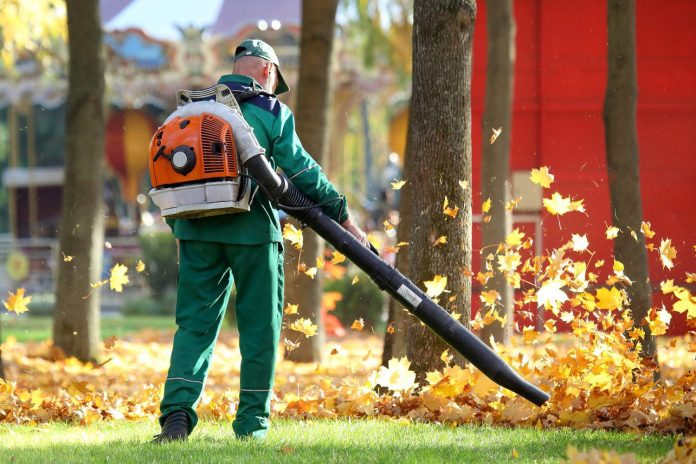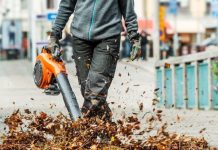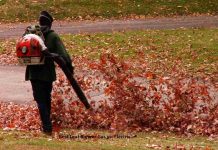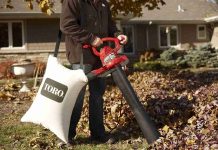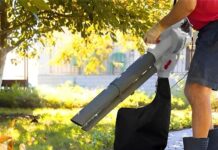In today’s article, we want to shed some light on a topic that may have crossed your mind before the negatives of leaf blowers.
We all know the satisfying feeling of a well-manicured lawn, but are these handy tools causing more harm than good?
Join us as we explore the various downsides of using leaf blowers, from the environmental impact to the potential health hazards they pose.
Noise pollution
High decibel levels
Depending on the model, leaf blowers are notorious for their high decibel levels, ranging from 70 to 100 decibels. This constant, loud noise can be highly disruptive to both our peace, as well as that of our neighbors. Whether enjoying a peaceful afternoon or trying to concentrate on work, the noise from leaf blowers can disturb our surroundings considerably.
Disruptive to peace
The noise generated by leaf blowers can disrupt the tranquility of our neighborhoods and outdoor spaces. This is particularly noticeable in residential areas, where the constant whirring, buzzing, and roaring of these machines can drown out the peaceful sounds of nature. It becomes increasingly challenging to enjoy outdoor activities, have conversations, relax, and unwind without constant background noise.
Negative impact on hearing
Prolonged exposure to high decibel levels can have a detrimental impact on our hearing. Leaf blowers produce noise levels that exceed recommended safe levels, putting our hearing at risk. Continual exposure to these loud noises can lead to temporary or permanent hearing damage, affecting our hearing ability and overall quality of life.
Disturbs sleep patterns
The noise pollution caused by leaf blowers can disrupt our sleep patterns and rob us of a good night’s rest. Many leaf blowers are operated early in the morning when people are still sleeping, making it difficult to get the recommended amount of sleep. The constant noise can be especially problematic for those who work irregular shifts, have night-time jobs, or are sensitive to disruptive sounds during sleep.
Air pollution
Exhaust emissions
Leaf blowers, especially gas-powered ones, emit harmful exhaust fumes that pollute the air. These emissions contain a variety of pollutants, such as carbon monoxide, nitrogen oxides, and volatile organic compounds (VOCs). These pollutants not only contribute to the worsening air quality but also pose health risks to individuals who are exposed to them.
Dispersal of dust and pollutants
Leaf blowers stir dust, dirt, and other particles on the ground, dispersing them into the air. This can worsen the air quality in our immediate surroundings and contribute to respiratory issues. Also, blowing leaves and debris around can disperse chemical pollutants or toxins on paved surfaces, further adding to the overall pollution.
Worsens air quality
The combination of exhaust emissions and the dispersal of dust and pollutants leads to a significant deterioration in air quality. As the particles become airborne and dispersed through the wind, they can be inhaled, leading to various health problems such as allergies, asthma, and respiratory infections. Moreover, the increased concentration of pollutants can have long-term effects on the environment, contributing to global warming and climate change.
Health risks for individuals
The air pollution caused by leaf blowers poses a considerable health risk, especially to individuals with respiratory conditions such as asthma or allergies. These individuals are susceptible to irritants in the air, and using leaf blowers can trigger or exacerbate their symptoms. Furthermore, the emissions emitted by leaf blowers can also cause respiratory distress, coughing, and wheezing in otherwise healthy individuals, affecting their overall well-being.
Environmental concerns
Disruption of natural ecosystems
Using leaf blowers can disrupt natural ecosystems by disturbing the delicate balance of flora and fauna. The powerful gusts of air produced by leaf blowers can uproot or damage plants, affecting various organisms’ natural habitats. This disruption can have long-lasting effects on the stability and diversity of these ecosystems.
Harmful impacts on wildlife
Not only do leaf blowers disrupt natural ecosystems, but they also directly harm wildlife. Small animals, insects, and birds can be injured or killed by the strong gusts of air produced by leaf blowers. Nests can be destroyed or dislodged, displacing or dying young birds and other animals. These harmful impacts on wildlife can disrupt food chains and ecological balance.
Killing beneficial insects
Leaf blowers are indiscriminate in removing leaves and debris, often unintentionally killing beneficial insects. These insects, such as bees and butterflies, play a vital role in pollination and the overall health of ecosystems. By removing their habitat and disrupting their natural environment, leaf blowers contribute to the decline of these essential pollinators.
Reduces biodiversity
The disturbance caused by leaf blowers can also reduce biodiversity by eliminating the natural diversity of plants and microorganisms within ecosystems. Native plant species, especially those that rely on fallen leaves for nutrient cycling, can be negatively impacted, potentially leading to the proliferation of invasive species. This reduction in biodiversity weakens ecosystems and negatively affects their ability to provide essential ecological services.
Allergies and respiratory issues
Stirring up allergens
Leaf blowers stir up allergens such as pollen, mold spores, and dust mites, making them more likely to be inhaled by individuals with allergies. These allergens can trigger allergic reactions, causing sneezing, itching, congestion, and watery eyes. The increased concentration of these allergens in the air can significantly impact the quality of life for allergy sufferers.
Increased risk of asthma attacks
For individuals with asthma, leaf blowers pose an elevated risk of triggering asthma attacks. The blowing action of these devices dislodges particles and allergens that can irritate the airways and lead to bronchospasms. Asthma attacks can be severe and even life-threatening, requiring immediate medical attention.
Irritates nasal passages
The dust and debris from leaf blowers can irritate the nasal passages, leading to discomfort and breathing difficulties. This can be particularly problematic for individuals with sensitive nasal passages or those prone to sinus congestion. The constant exposure to airborne particles can cause inflammation and exacerbate existing respiratory conditions.
Aggravates existing respiratory conditions
Leaf blowers can significantly worsen respiratory conditions such as chronic obstructive pulmonary disease (COPD), bronchitis, and emphysema. The pollutants and irritants emitted and dispersed by these machines can inflame the airways, leading to increased coughing, wheezing, and shortness of breath. Individuals with pre-existing respiratory conditions are particularly vulnerable to these adverse effects.
Inefficient and wasteful
Limited effectiveness in heavy debris
While leaf blowers can effectively remove light, dry leaves, they often struggle with heavier debris. Wet leaves, branches, or larger debris can be difficult to blow away, requiring additional effort or alternative tools. This limitation can make using leaf blowers inefficient and frustrating for heavy debris tasks.
Blowing leaves into neighbors’ yards
One of the downsides of leaf blowers is that they tend to blow leaves and debris into neighboring yards instead of effectively removing or containing them. This can create tension among neighbors, as it can be seen as an inconsiderate act and a nuisance to clean up someone else’s debris. The unwillingness or inability to control the direction of the blowing can lead to unnecessary conflicts.
Wasted energy consumption
Leaf blowers are typically powered by gasoline or electricity, contributing to energy consumption. Gas-powered leaf blowers consume fossil fuels, adding to greenhouse gas emissions and contributing to climate change. Although more environmentally friendly regarding emissions, electric leaf blowers still require electricity, which might be derived from non-renewable sources. This wasteful energy consumption adds to the overall environmental impact.
Requires additional clean-up
While the primary purpose of leaf blowers is to remove leaves and debris from outdoor spaces, their usage often leads to additional clean-up efforts. The blown debris may be scattered in unintended areas, requiring additional time and effort to gather and dispose of properly. This defeats the purpose of using a leaf blower in the first place and adds unnecessary chores to our already busy lives.
Lack of personal safety
Risk of flying projectiles
The powerful gusts of air produced by leaf blowers can pick up and propel small objects or debris at high speeds, becoming potential flying projectiles. These projectiles can cause injury to both the operator and bystanders, posing a significant risk to personal safety. Being hit by these flying objects can lead to cuts, bruises, or more severe injuries.
Accidental tripping hazards
The presence of leaf blowers, cords, or hoses can create accidental tripping hazards for the operator and anyone nearby. The trailing cords or hoses can go unnoticed, especially in a busy or cluttered environment, causing individuals to trip and potentially fall. This can result in sprains, fractures, or even head trauma.
Potential for injury due to improper usage
Improper usage of leaf blowers can lead to accidents and injuries. Individuals unfamiliar with the correct handling and safety procedures may misuse the equipment or fail to follow necessary precautions. This can result in burns, cuts, electrical shocks, or even more severe injuries if the equipment malfunctions or safety guidelines are disregarded.
Safety concerns for operators and bystanders
Leaf blowers emit strong gusts of air that can be hazardous to operators and bystanders. The forceful airflow can redirect loose clothing, hair, or accessories towards the machine’s intake, potentially causing entanglement or injury. Additionally, the noise produced by leaf blowers can damage hearing, requiring operators and bystanders to wear hearing protection for prolonged exposure.
Financial costs
The expense of purchasing and maintaining
Leaf blowers come with a significant financial cost, both in purchasing and maintaining the equipment over time. Depending on the type and quality of the leaf blower, prices can range from relatively affordable to quite expensive. Furthermore, regular maintenance, such as fuel or battery replacements and repairs, can add to the overall cost of ownership.
Frequent fuel and electricity usage
For gas-powered leaf blowers, the constant need for fuel can add up in cost and environmental impact. These machines use gasoline, requiring frequent gas station trips and ongoing expenses. Electric leaf blowers require electricity, leading to higher energy bills and continued reliance on non-renewable energy sources.
Repairs and replacement parts
Like any equipment, leaf blowers may require repairs or replacement parts over time. Mechanical components, such as filters, belts, or spark plugs, can wear out or break, necessitating costly repairs or part replacements. These additional expenses can accumulate and add to the overall financial burden of owning and maintaining a leaf blower.
Economic burden on individuals and communities
The financial costs associated with leaf blowers extend beyond individual buyers and operators. The costs can be significant in communities where leaf blowers are extensively used, such as in landscaping or maintenance services. These expenses ultimately trickle down to consumers, who may end up paying higher prices for services that rely heavily on using leaf blowers.
Inconsiderate to others
Disturbance to neighbors
The noise, air pollution, and general disruption caused by leaf blowers can be highly inconsiderate to our neighbors. Operating leaf blowers early in the morning or late in the evening can disrupt their peace and privacy, making it difficult for them to enjoy their homes or outdoor spaces. Neglecting the impact of leaf blower usage on the well-being of those around us shows a lack of consideration for the needs and comfort of our neighbors.
Ignoring noise restrictions
Many neighborhoods or municipalities have noise restrictions to protect residents from excessive noise pollution. Operating leaf blowers in violation of these restrictions disregards the established rules and regulations and shows a lack of respect for the shared environment. Ignoring noise restrictions can result in fines, penalties, or legal action, further exacerbating tensions within the community.
Disrespect for peace and privacy
Using leaf blowers excessively or at inappropriate times displays a lack of respect for peace and privacy. The constant noise intrusion disrupts the ability to relax, concentrate, or enjoy quiet moments in our homes or outdoor spaces. Demonstrating respect for peace and privacy entails finding alternative, less disruptive methods for maintaining our yards and ensuring a harmonious coexistence with those around us.
Creates tensions and conflicts
The inconsiderate use of leaf blowers can create tensions and conflicts among neighbors, leading to strained relationships and ongoing disputes. The constant noise and disregard for others’ well-being can breed resentment and frustration, turning a once harmonious neighborhood into a place of discord. Promoting understanding, communication, and compromises can help maintain peaceful and respectful interactions among community members.
Time-consuming
Requires repetitive and lengthy tasks
Using a leaf blower often involves repetitive and time-consuming tasks. The need to repeatedly blow leaves and debris from various areas of our yards or outdoor spaces can become monotonous and tedious. This repetitive task can quickly drain our time and energy, leaving us with less time for other activities or pursuits.
Slows down overall yard maintenance
While leaf blowers may seem like a quick solution for clearing leaves and debris, they can slow down the overall process of yard maintenance. Rather than efficiently removing and disposing of the debris, leaf blowers can scatter it in different areas, requiring additional time and effort to collect and clean up. This inefficiency can delay or extend the time to complete yard maintenance tasks.
Inefficient usage of time and effort
Despite their powerful blowers, leaf blowers can often be inefficient in the overall effort required to maintain our yards. Instead of providing a time-saving solution, they can add unnecessary steps and complications to the process. This inefficient usage of time and effort can lead to frustration and wasted productivity.
Adds unnecessary chores
Using leaf blowers can introduce additional and unnecessary chores into our daily lives. Instead of enjoying the beauty of nature or engaging in activities that bring us joy or relaxation, we find ourselves constantly chasing leaves and debris around our yards. This constant battle with nature’s elements can take away from the time we would rather spend on leisure or quality time with loved ones.
Addiction and dependence
Reliance on leaf blowers
The convenience and perceived efficiency of leaf blowers can lead to a reliance on their usage. Once we become accustomed to using leaf blowers to maintain our yards, we may find transitioning to alternative leaf removal methods challenging. This reliance on leaf blowers can foster a sense of dependence and make it challenging to break free from the habit.
Reluctance to explore alternative methods
The addiction to leaf blowers often comes with a reluctance to explore alternative methods of removing leaves and debris. Raking leaves or using manual tools might be perceived as more time-consuming and labor-intensive, leading to resistance to adopting these methods. This reluctance to explore alternative methods further reinforces the dependence on leaf blowers and perpetuates unsustainable practices.
Contributing to unsustainable practices
The addiction to leaf blowers contributes to unsustainable practices in multiple ways. The energy consumption, air pollution, noise pollution, and negative environmental impact all result from the continued and excessive use of leaf blowers. By perpetuating these unsustainable practices, we contribute to the overall deterioration of our surroundings and the planet.
Difficulty breaking the habit
Breaking the habit of using leaf blowers can be challenging, especially when we have become accustomed to their convenience and perceived efficiency.
However, we can pave the way for change with awareness and a commitment to reducing our environmental impact.
Exploring alternative methods, such as rakes, brooms, or even embracing the natural process of leaf decomposition, can shift away from the addiction to leaf blowers and towards more sustainable practices.

